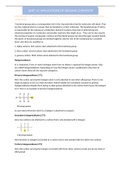Essay
Unit 14 A btec applied science level 3
- Course
- Institution
Understand the structures, reactions and properties of functional group compounds. A. D1 Analyse the types of reaction mechanisms undergone by non-carbonyl and carbonyl compounds. A.M1 Construct mechanisms for non-carbonyl and carbonyl compounds. A. M2 Plan a multi-step synth...
[Show more]



